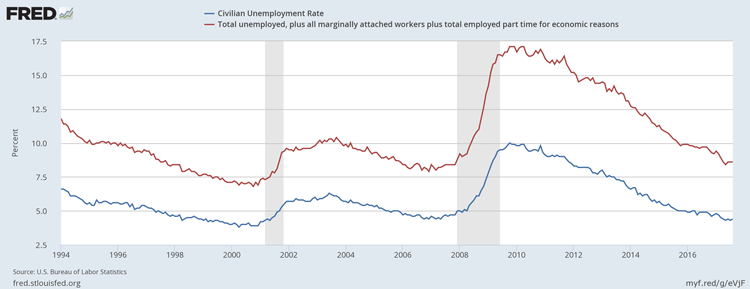News & information
Economics
The Bureau of Labor Statistics today released its employment numbers for August 2017. The economy added 156,000 jobs, falling short of the 176,000 average for 2017, as unemployment increased slightly to 4.4 percent from 4.3 percent in July. Average hourly earnings increased $0.03 to $26.39, an increase of 2.46 percent since August 2016. The labor force participation rate stayed at 62.9 percent, but that remains one of the lowest rates since the late 1970s.
While the official numbers show a slight uptick in the civilian unemployment rate, many economists prefer to use a metric known as U6 to get a more realistic sense of the employment situation in the economy. U6 includes many variables that are not present in the official government numbers, such as discouraged workers and those working part time but would like to work full time. For example, in the official numbers an individual working one hour per week and wanting a full time job is counted as employed. U6 also includes discouraged workers who have stopped looking for work because economic conditions have convinced them that no work is available.
The U6 rate stayed at 8.6 percent for August 2017, a figure that has held since June 2017 although it has decreased from 9.7 percent in August 2016. While this is far lower than the 17.1 percent U6 rate in March 2010, job growth in the wake of the Great Recession has been sluggish, and low-wage, part-time work has become the norm. According to the Economic Policy Institute, the number of part-time workers has increased 44.6 percent from 2007. This new normal partly explains the persistent high level of U6.
Below is a graph generated by NALC's Research Department, using data from the St. Louis Federal Reserve, showing the difference between the civilian unemployment rate (U3) and the total unemployment rate (U6). The shaded areas represent recessions. As the data shows, the civilian unemployment rate vastly underestimates the actual rate of unemployment in the economy.

